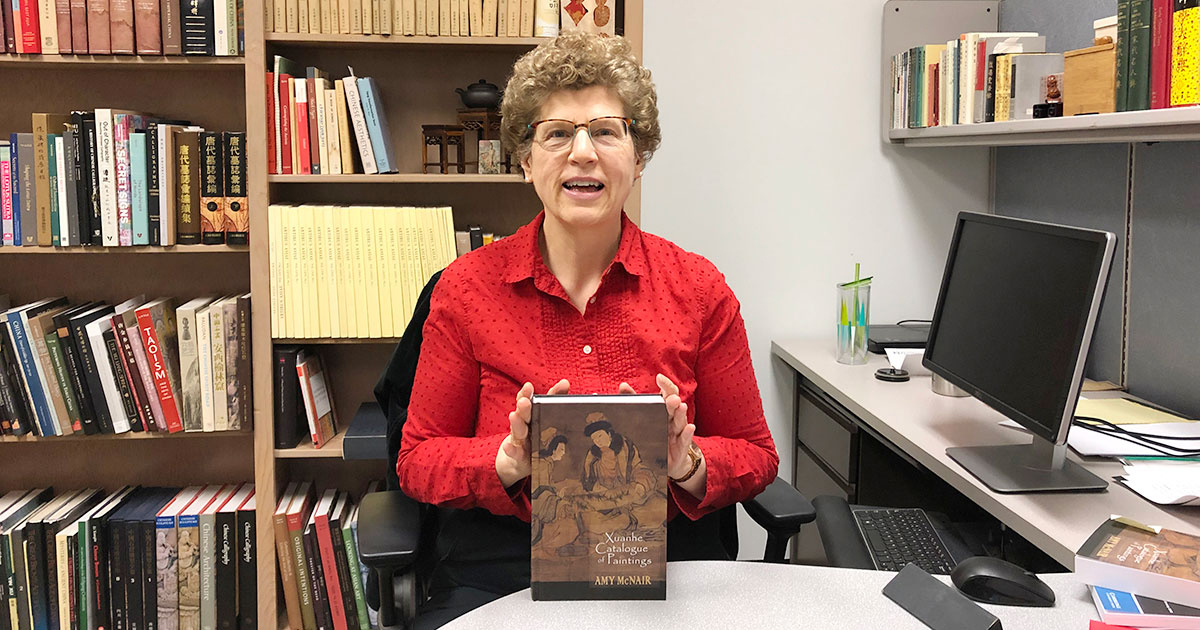Emperor’s art catalog gives window into ancient China

LAWRENCE — After the Golden Horde swarmed over the Great Wall of China and dethroned the Northern Song Dynasty in 1127, deposed Emperor Huizong became known as a dilettante who collected over 6,000 paintings and worked on his own art while ignoring the country’s defense. But a new book by a University of Kansas researcher shows he was barely one-sixth that bad.
Amy McNair specializes in Chinese art history as a professor in the Kress Foundation Department of Art History and has just published her third book, “Xuanhe Catalogue of Paintings: An Annotated Translation with an Introduction” (Cornell University East Asian Program, 2019).
It took her more than a decade to translate the work from 12th-century Chinese into English, which had never been done before. It’s a list of more than 6,000 paintings in Huizong’s collection, along with a biographical sketch of each artist.
“It's a well-known text in the field,” McNair said. “This catalog was dated to the year 1120. And it is meant as an inventory of the imperial painting collection. But in addition to the inventory, it also has these biographies. … For every person that's in here, there's a short biography, and then there's a list of the pictures in the palace that were by that person.”
McNair said the art was produced as early as the 3rd century A.D., all the way up to the time Huizong was deposed. Only about two dozen examples remain extant today, she said, each of them famous in the art world.
The original author or authors of the catalog are unknown.
“The emperor loved paintings, and he would keep some in his own private quarters,” McNair said. Others were undoubtedly held in libraries and other archives.
“He is a classic, so-called, heavy scare quotes 'bad last emperor' in that he lost his dynasty. It’s a violation of filial piety. It's bad in every way it could possibly be,” McNair said.
“So you ask yourself what was Huizong doing instead of governing the realm and fighting off the Tatars? He was focused on art. He himself was famous as a calligrapher and painter and famous as a collector. And this is supposedly the catalog of his painting collection.
“Everybody thinks he was such a collector that he collected 6,396 paintings between 1100 and 1126. But what I found out from translating this is that is not true. I found out by analyzing the lists of paintings, as well as reading the biographies, that at least 5,000 of these paintings were already in the collection, collected by his predecessors.
“So he was still a prolific collector, but not that prolific.”
And while McNair is not a military historian, she thinks Huizong gets a bad rap.
“I don't know that there was much they could do,” McNair said. “I think time was against them.”
McNair said she faced difficulties in translating the catalog. For one thing, she said, “It’s a badly written book. Their literary Chinese is not good. It makes it more of a challenge.”
Yet McNair said she resisted the temptation to edit out imperfections in the original work in her translation.
Making this catalog of ancient art and artists available to the English-speaking world today, McNair said, “gives us an amazing window into what the subjects were of interest to people, what was collected, what was the value to them. It gives you an idea of the taste of the time.”
Huizong was renowned for his love of antique paintings by famous masters, pictures of flowers and birds and, because he was a devoted practitioner of religious Daoism, imagery of Daoist immortals and deities. He added many such pictures during his reign.
McNair said the authors of his catalog “created” some famous old masters by attributing anonymous paintings to them.
“That’s another way to build a collection,” she said.
Photo: Amy McNair holds a copy of her new book. Credit: Rick Hellman / KU News Service.